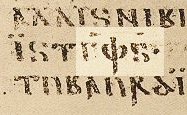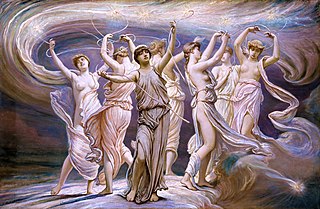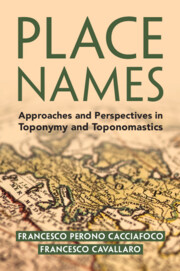Related Research Articles
In grammar, the nominative case, subjective case, straight case, or upright case is one of the grammatical cases of a noun or other part of speech, which generally marks the subject of a verb, or a predicative nominal or adjective, as opposed to its object, or other verb arguments. Generally, the noun "that is doing something" is in the nominative, and the nominative is often the form listed in dictionaries.

Polis, plural poleis, means ‘city’ in ancient Greek. The modern Greek word πόλη (polē) is a direct descendant of the ancient word and roughly means "city" or an urban place. However, the Ancient Greek term that specifically meant the totality of urban buildings and spaces was asty (ἄστυ), rather than polis.
Toponymy, toponymics, or toponomastics is the study of toponyms, including their origins, meanings, usage and types. Toponym is the general term for a proper name of any geographical feature, and full scope of the term also includes proper names of all cosmographical features.
In linguistics, homonyms are words which are either homographs—words that have the same spelling —or homophones—words that have the same pronunciation —or both. Using this definition, the words row, row and row are homonyms because they are homographs ; so are the words see (vision) and sea, because they are homophones.

A hydronym is a type of toponym that designates a proper name of a body of water. Hydronyms include the proper names of rivers and streams, lakes and ponds, swamps and marshes, seas and oceans. As a subset of toponymy, a distinctive discipline of hydronymy studies the proper names of all bodies of water, the origins and meanings of those names, and their development and transmission through history.
Anthroponymy is the study of anthroponyms, the proper names of human beings, both individual and collective. Anthroponymy is a branch of onomastics.

The English word god comes from the Old English god, which itself is derived from the Proto-Germanic *gudą. Its cognates in other Germanic languages include guþ, gudis, guð, god, and got.
In linguistics, statistical semantics applies the methods of statistics to the problem of determining the meaning of words or phrases, ideally through unsupervised learning, to a degree of precision at least sufficient for the purpose of information retrieval.

Alcyone, in Greek mythology, was the name of one of the Pleiades, daughters of Atlas and Pleione or, more rarely, Aethra. She attracted the attention of the god Poseidon and bore him several children, variously named in the sources: Hyrieus, Hyperenor, and Aethusa; Hyperes and Anthas; and Epopeus. By a mortal, Anthedon, Alcyone became the mother of the fisherman Glaucus, who was later transformed into a marine god.
The Society for Name Studies in Britain and Ireland (SNSBI) is a registered charity and a learned society of members with interests in proper names, including place-names, personal names, and surnames relating to the British Isles.
Metaphorand metonymy are two fundamental opposite poles along which a discourse with human language is developed. It has been argued that the two poles of similarity and contiguity are fundamental ones along which the human mind is structured; in the study of human language the two poles have been called metaphor and metonymy, while in the study of the unconscious they have been called condensation and displacement. In linguistics, they are connected to the paradigmatic and syntagmatic poles.
Macedonian onomastics is part of Macedonian studies that studies names, surnames, and nicknames in Macedonian. This is a relatively new linguistic discipline. In Macedonia, and in Macedonian studies in general, it developed during the 19th century, when the first few research results have been provided. The onomastics for a long period of time has been considered as part of various scientific disciplines, such as geography, history or ethnography, until it became a discipline on its own in the 20th century. Macedonian onomastics, generally speaking, is divided into toponomastics and anthroponomastics.

Scottish toponymy derives from the languages of Scotland. The toponymy varies in each region, reflecting the linguistic history of each part of the country.
Constantine Sandis is a Greek and British philosopher and entrepreneur. Having worked on philosophy of action, moral psychology, David Hume, and Ludwig Wittgenstein, in 2013 he became Professor of Philosophy at Oxford Brookes University. He is currently Visiting Professor of Philosophy at the University of Hertfordshire and a Founding Director of author services firm Lex Academic.
A theonym is a proper name of a deity.
Elaine Matthews BA BPhil was a British classical scholar at the University of Oxford and one of the principal contributors to the Lexicon of Greek Personal Names.
Choronym is a linguistic term that designates a proper name of an individual region or a country. The study of regional and country names is known as choronymy, or choronymics. Since choronyms are a subclass of toponyms, choronymic studies represent a distinctive subfield of toponymic studies and belong to the wider field of onomastic studies.

Place Names: Approaches and Perspectives in Toponymy and Toponomastics is a book by linguists and authors Francesco Perono Cacciafoco and Francesco Paolo Cavallaro. The book explores toponymy and toponomastics. Through associating these studies with various disciplines and elucidating key methodologies with illustrative case studies, the volume provides an introduction to the origins, structures, and significance of place names worldwide. It was published in March 2023 by Cambridge University Press.
References
- ↑ Carsenat, Elian (2013). "Onomastics and Big Data Mining". arXiv: 1310.6311 [cs.CY].
- ↑ Mitzlaff, Folke; Stumme, Gerd (2013). "Onomastics 2.0 - The Power of Social Co-Occurrences". arXiv: 1303.0484 [cs.IR].
- ↑ Crymble, Adam (2017-02-09). "How Criminal were the Irish? Bias in the Detection of London Currency Crime, 1797-1821". The London Journal. 43: 36–52. doi: 10.1080/03058034.2016.1270876 . hdl: 2299/19710 .
- ↑ Crymble, Adam (2015-07-26). "A Comparative Approach to Identifying the Irish in Long Eighteenth-Century London" (PDF). Historical Methods. 48 (3): 141–152. doi:10.1080/01615440.2015.1007194. hdl: 2299/16184 . S2CID 161595975. Archived (PDF) from the original on 2020-03-14. Retrieved 2017-08-27.
- ↑ ὀνομαστικός Archived 2020-08-05 at the Wayback Machine , Henry George Liddell, Robert Scott, A Greek-English Lexicon, on Perseus project
- ↑ "Online Etymology Dictionary". etymonline.com. Archived from the original on 27 August 2017. Retrieved 26 July 2015.
- ↑ ὄνομα Archived 2021-02-25 at the Wayback Machine , Henry George Liddell, Robert Scott, A Greek-English Lexicon, on Perseus project
- ↑ Cacciafoco, Francesco Perono; Cavallaro, Francesco (2023). Place Names: Approaches and Perspectives in Toponymy and Toponomastics.
- ↑ Bruck, Gabriele (2009). The Anthropology of Names and Naming.
- ↑ Alvarez-Altman, Grace; Burelbach, Frederick M. (1987). Names in Literature: Essays from Literary Onomastics Studies.
- ↑ Ainiala, Terhi; Östman, Jan-Ola (2017). Socio-onomastics:The pragmatics of names.